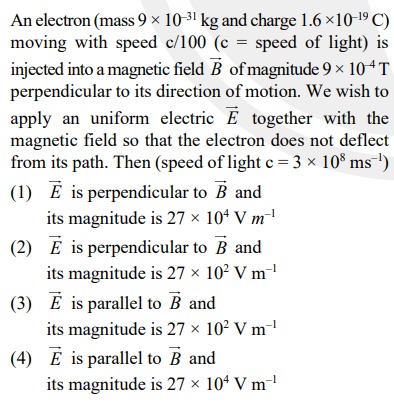Question
Question: An electron (mass 9 × 10⁻³¹ kg and charge 1.6×10⁻¹⁹ C) moving with speed c/100 (c = speed of light) ...
An electron (mass 9 × 10⁻³¹ kg and charge 1.6×10⁻¹⁹ C) moving with speed c/100 (c = speed of light) is injected into a magnetic field B of magnitude 9 × 10⁻⁴ T perpendicular to its direction of motion. We wish to apply a uniform electric E together with the magnetic field so that the electron does not deflect from its path. Then (speed of light c = 3 × 10⁸ ms⁻¹)

E is perpendicular to B and its magnitude is 27 × 10⁴ V m⁻¹
E is perpendicular to B and its magnitude is 27 × 10² V m⁻¹
E is parallel to B and its magnitude is 27 × 10² V m⁻¹
E is parallel to B and its magnitude is 27 × 10⁴ V m⁻¹
E is perpendicular to B and its magnitude is 27 × 10² V m⁻¹
Solution
The electron moves undeflected in the combined electric and magnetic fields. The net force on the electron must be zero. The forces acting on the electron are the electric force FE=qE and the magnetic force FB=q(v×B).
For undeflected motion, the net force is zero: FE+FB=0 qE+q(v×B)=0 Since q=0, we can divide by q: E+(v×B)=0 E=−(v×B)
This equation gives the required electric field E. From this equation, we can see that E must be perpendicular to both v and B, because v×B is a vector perpendicular to both v and B. The magnitude of E is E=∣v×B∣.
We are given that the magnetic field B is perpendicular to the direction of motion v. So, the angle between v and B is 90∘. The magnitude of the cross product is ∣v×B∣=vBsinθ, where θ is the angle between v and B. Since θ=90∘, sinθ=1. So, the magnitude of E is E=vB.
The speed of the electron is given as v=c/100, where c=3×108 m/s. v=1003×108 m/s=3×106 m/s. The magnitude of the magnetic field is given as B=9×10−4 T.
The magnitude of the electric field is: E=vB=(3×106 m/s)×(9×10−4 T) E=(3×9)×(106×10−4) V/m E=27×106−4 V/m E=27×102 V/m
The direction of E must be perpendicular to both v and B. Since v and B are perpendicular to each other, v×B is perpendicular to both v and B. Thus, E=−(v×B) is also perpendicular to both v and B.
Therefore, E is perpendicular to B.
